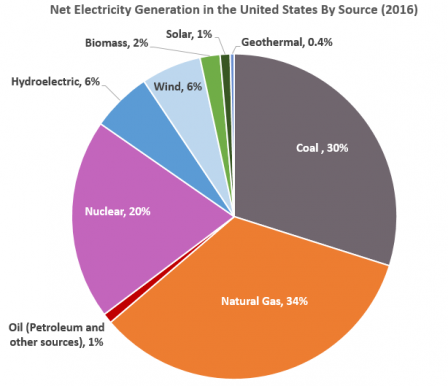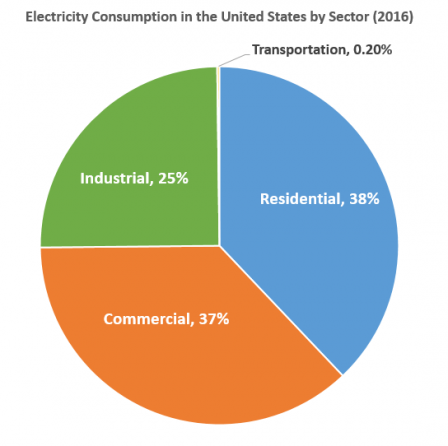About the U.S. Electricity System and its Impact on the Environment
The U.S. Electricity System
Today’s U.S. electricity system is a complex network of power plants, transmission and distribution wires, and end-users of electricity. Today, most Americans receive their electricity from centralized power plants that use a wide variety of energy resources to produce electricity, such as coal, natural gas, nuclear energy, or renewable resources such as water, wind, or solar energy. This complex system of generation, delivery, and end-users is often referred to as the electric power grid.
Use the diagram below to learn more about the electric power grid. Click each component to get an overview with links to more detailed information.
View a text version of this diagram ►
 Source: U.S. Energy Information Administration, Electricity Data Browser. These data were accessed in December 2017.How and where electricity is generated
Source: U.S. Energy Information Administration, Electricity Data Browser. These data were accessed in December 2017.How and where electricity is generated
Electricity in the United States is generated using a variety of resources. The three most common are natural gas, coal, and nuclear power. Some of the fastest growing sources are renewable resources such as wind and solar. Most U.S. electricity is generated at centralized power plants. A much smaller but growing amount of electricity is produced through distributed generation—a variety of technologies that generate electricity at or near where it will be used, such as onsite solar panels and combined heat and power. Learn more about centralized and distributed generation.
Electricity delivery and use
Once electricity is generated at a centralized power plant, it travels through a series of interconnected, high-voltage transmission lines. Substations “step down” high-voltage power to a lower voltage, sending the lower voltage electricity to customers through a network of distribution lines. Learn more about electricity delivery.
Residential, commercial, and industrial customers each account for roughly one-third of the nation’s electricity use. The transportation sector accounts for a small fraction of electricity use. Learn more about end-users of electricity.
 Source: U.S. Energy Information Administration, Electricity Data Browser. These data were accessed in December 2017.How the grid matches generation and demand
Source: U.S. Energy Information Administration, Electricity Data Browser. These data were accessed in December 2017.How the grid matches generation and demand
The amount of electricity used in homes and businesses depends on the day, the time, and the weather. For the most part, electricity must be generated at the time it is used. Electric utility companies and grid operators must work together to generate the right amount of electricity to meet demand. When demand increases, operators can respond by increasing production from power plants that are already operating, generating electricity from power plants that are already running at a low level or on standby, importing electricity from distant sources, or calling on end-users who agreed to consume less electricity from the grid.
Environmental Impacts of the Electricity System
Nearly all parts of the electricity system can affect the environment, and the size of these impacts will depend on how and where the electricity is generated and delivered. In general, the environmental effects can include:
- Emissions of greenhouse gases and other air pollutants, especially when a fuel is burned.
- Use of water resources to produce steam, provide cooling, and serve other functions.
- Discharges of pollution into water bodies, including thermal pollution (water that is hotter than the original temperature of the water body).
- Generation of solid waste, which may include hazardous waste.
- Land use for fuel production, power generation, and transmission and distribution lines.
- Effects on plants, animals, and ecosystems that result from the air, water, waste, and land impacts above.
Some of these environmental effects can also potentially affect human health, particularly if they result in people being exposed to pollutants in air, water, or soil.
- Visit EPA’s Learn the Issues area to learn more about how the condition of the environment can affect human health
- Visit the centralized generation, distributed generation, and electricity delivery pages to learn more about specific environmental impacts from each part of the electricity system.
The environmental effects of the electricity you use will depend on the sources of generation (the “electricity mix”) available in your area. To learn about the emissions generated by the electricity that you use, visit EPA’s Power Profiler.
You can reduce the environmental effects of your electricity use by buying green power and by becoming more energy-efficient. Learn more about how to reduce your impact.
More broadly, several solutions can help reduce the negative environmental impacts associated with generating electricity, including:
- Energy efficiency. End-users can meet some of their needs by adopting energy-efficient technologies and practices. In this respect, energy efficiency is a resource that reduces the need to generate electricity. Learn more about energy efficiency.
- Clean centralized generation. New and existing power plants can reduce environmental impacts by increasing generation efficiency, installing pollution controls, and leveraging cleaner energy supply resources. Learn more about centralized generation.
- Clean distributed generation. Some distributed generation, such as distributed renewable energy, can help support delivery of clean, reliable power to customers and reduce electricity losses along transmission and distribution lines. Learn more about distributed generation.
- Combined heat and power (CHP). Also known as cogeneration, CHP produces electricity and heat simultaneously from the same fuel source. By using heat that would otherwise be wasted, CHP is both distributed generation and a form of energy efficiency. Learn more about CHP.
